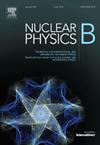Fractional vorticity, Bogomol'nyi-Prasad-Sommerfield systems and complex structures for the (generalized) spinor Gross-Pitaevskii equations
IF 2.5
3区 物理与天体物理
Q2 PHYSICS, PARTICLES & FIELDS
引用次数: 0
Abstract
The (generalized) Gross-Pitaevskii equation (GPE) for a complex scalar field in two spatial dimensions is analyzed. It is shown that there is an infinite family of self-interaction potentials which admit Bogomol'nyi-Prasad-Sommerfield (BPS) bounds together with the corresponding first-order BPS systems. For each member of this family, the solutions of the first-order BPS systems are automatically solutions of the corresponding second-order generalized GPE. The simplest topologically non-trivial solutions of these first-order BPS systems describe configurations with quantized fractional vorticity. The corresponding fraction is related to the degree of non-linearity. The case in which the self-interaction potential is of order six (namely , which is a relevant theory both in relativistic quantum field theories in dimensions in connection with the quantum Hall effect as well as in the theory of the supersolids) is analyzed in detail. Such formalism can also be extended to the case of quantum mixtures with multi-component GPEs. The relationship between these techniques and supersymmetry will be discussed. In particular, despite several common features, we will show that there are multi-component GPEs that are not supersymmetric (at least, not in the standard sense) and possess a BPS system of the above type.
分数涡度,Bogomol'nyi-Prasad-Sommerfield系统和(广义)旋量Gross-Pitaevskii方程的复杂结构
分析了二维复标量场的广义Gross-Pitaevskii方程(GPE)。证明了存在一个无限族的自相互作用势,其允许Bogomol'nyi-Prasad-Sommerfield (BPS)界以及相应的一阶BPS系统。对于这个族的每一个成员,一阶BPS系统的解都是相应的二阶广义GPE的自动解。这些一阶BPS系统的最简单拓扑非平凡解描述了量子化分数涡量的构型。相应的分数与非线性程度有关。详细分析了自相互作用势为六阶的情况(即|Ψ|6,这是与量子霍尔效应相关的(2+1)维相对论量子场论以及超固体理论中的相关理论)。这种形式也可以推广到具有多组分gpe的量子混合物的情况。本文将讨论这些技术与超对称的关系。特别是,尽管有几个共同的特征,我们将证明存在非超对称(至少不是标准意义上的)且具有上述类型的BPS系统的多组分gpe。
本文章由计算机程序翻译,如有差异,请以英文原文为准。
求助全文
约1分钟内获得全文
求助全文
来源期刊

Nuclear Physics B
物理-物理:粒子与场物理
CiteScore
5.50
自引率
7.10%
发文量
302
审稿时长
1 months
期刊介绍:
Nuclear Physics B focuses on the domain of high energy physics, quantum field theory, statistical systems, and mathematical physics, and includes four main sections: high energy physics - phenomenology, high energy physics - theory, high energy physics - experiment, and quantum field theory, statistical systems, and mathematical physics. The emphasis is on original research papers (Frontiers Articles or Full Length Articles), but Review Articles are also welcome.
 求助内容:
求助内容: 应助结果提醒方式:
应助结果提醒方式:


